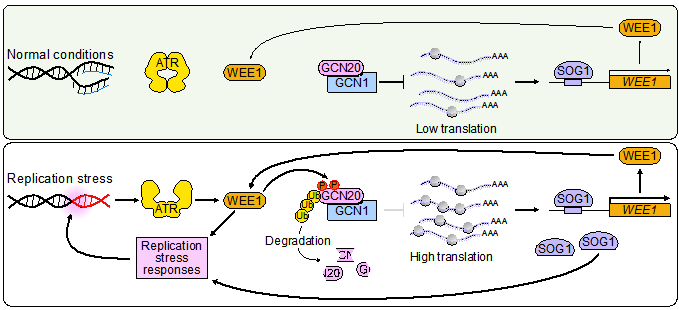南湖新闻网讯(通讯员 陈汉臣) 所有生物都需要通过DNA复制将其遗传信息传递给下一代。然而,DNA复制经常受到各种外源和内源因素的干扰,造成DNA复制胁迫。生物进化了复杂而精细的复制胁迫应答机制以保证复制的正确性。高度保守的蛋白激酶模块ATR-WEE1在复制胁迫应答中起关键作用。但是,它们在植物中的作用机制是一个长期悬而未决科学问题。在前期的研究中,严顺平团队发现ATR-WEE1通过负调控SOAT1 (FBL17) 和SOAT2 (PRL1) 激活复制胁迫应答。
5月9日,我校生命科学技术学院严顺平团队在国际期刊The Plant Cell发表了题为 “The ATR-WEE1 kinase module promotes SUPPRESSOR OF GAMMA RESPONSE 1 translation to activate replication stress responses” 的研究论文,发现了ATR-WEE1模块通过负调控SOAT3 (GCN20) 激活复制胁迫应答的新机制。
在该研究中,作者通过正向遗传筛选发现突变SOAT3可以部分挽救拟南芥atr和wee1突变体对复制胁迫的超敏感性。进一步研究发现,SOAT3编码翻译抑制蛋白GCN20;WEE1磷酸化GCN20;被磷酸化的GCN20被多聚泛素化,并通过26S蛋白酶体被降解;GCN20抑制转录因子SOG1的翻译。因此,WEE1通过解除GCN20对SOG1的翻译抑制促进SOG1的翻译。前人的研究发现,SOG1正调控WEE1的转录。所以,WEE1与SOG1形成正反馈,共同保证复制胁迫应答的正常启动。

WEE1-GCN20调控复制胁迫应答的工作模型
该研究发现了WEE1的新底物GCN20,揭示了ATR-WEE1调控复制胁迫应答的新机制。此外,该研究首次揭示了SOG1在翻译水平被调控的机制,将翻译调控与复制胁迫应答联系起来。
严顺平团队已毕业的博士生陈汉臣和博士后潘婷为该论文的共同第一作者,严顺平教授为通讯作者,王利利研究员也参与研究工作。该研究得到了国家自然科学基金、华中农业大学-中国农业科学院深圳农业基因组研究所合作基金、中国博士后基金等项目的资助。
据悉,严顺平教授于2014年回国后开启了植物DNA损伤应答机制的新方向,取得了系统性的原创成果,揭示了WEE1调控细胞周期暂停的机制、SOG1调控DNA损伤修复的机制、SMC5/6协同调控细胞周期暂停和DNA损伤修复的机制,大大丰富了人们对植物DNA损伤应答的认识。近5年,以通讯作者(含共同)在Nature Plants、EMBO Journal、PNAS (2篇)、Plant Cell (3篇)、Molecular Plant、Nucleic Acids Research、New Phytologist等杂志发表论文13篇。
【英文摘要】
DNA replication stress threatens genome stability and is a hallmark of cancer in humans. The evolutionarily conserved kinases ATR (ATM and RAD3-related) and WEE1 are essential for the activation of replication stress responses. Translational control is an important mechanism that regulates gene expression, but its role in replication stress responses is largely unknown. Here we show that ATR-WEE1 control the translation of SUPPRESSOR OF GAMMA RESPONSE 1 (SOG1), a master transcription factor required for replication stress responses in Arabidopsis thaliana. Through genetic screening, we found that the loss of GENERAL CONTROL NONDEREPRESSIBLE 20 (GCN20) or GCN1, which function together to inhibit protein translation, suppressed the hypersensitivity of the atr or wee1 mutant to replication stress. Biochemically, WEE1 inhibits GCN20 by phosphorylating it; phosphorylated GCN20 is subsequently polyubiquitinated and degraded. Ribosome profiling experiments revealed that that loss of GCN20 enhanced the translation efficiency of SOG1, while overexpressing GCN20 had the opposite effect. The loss of SOG1 reduced the resistance of wee1 gcn20 to replication stress, whereas overexpressing SOG1 enhanced the resistance to atr or wee1 to replication stress. These results suggest that ATR-WEE1 inhibits GCN20-GCN1 activity to promote the translation of SOG1 during replication stress. These findings link translational control to replication stress responses in Arabidopsis.
论文链接:https://doi.org/10.1093/plcell/koad126
审核人:严顺平